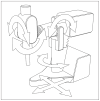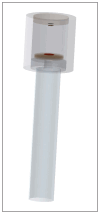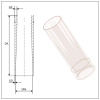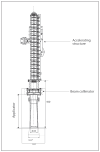Design and performance validation of a novel 3d printed thin-walled and transparent electron beam applicators for intraoperative radiation therapy with beam energy up to 12 MeV
- PMID: 39144271
- PMCID: PMC11321790
- DOI: 10.5603/rpor.101092
Design and performance validation of a novel 3d printed thin-walled and transparent electron beam applicators for intraoperative radiation therapy with beam energy up to 12 MeV
Abstract
A high-energy electron accelerator is used in the treatment of patients in the so-called intraoperative electron radiotherapy (IOERT). The work aimed to present the results of the validation of a new design of an electron beam applicator for use in IOERT. A novel solution was described along with the design optimization method based on Monte Carlo simulations. In this solution, the applicator consists of two parts. The lower exchangeable part collimates the therapeutic field. Measurements were made based on the International Electrotechnical Commission (IEC) standard recommendations. The measurement described in the standard has been adapted to the specificity of the intraoperative accelerator Source to Skin Distance - of 60 cm and applicators with a circular cross-sectional area. Measurements were performed for nominal beam energies of 6, 10, and 12 MeV and two therapeutic field diameters of 6 and 10 cm. The dose due to stray X-ray radiation in all energies is less than 0.3% and increases for energies from 6 to 12 MeV by 2.9 times from 0.1 for 6MeV to 0.29 for 12 MeV. The average dose due to leakage radiation also shows an increasing trend and is higher for a 6 cm diameter applicator. Validation confirmed the usefulness of the novel applicator design for clinical applications. Thanks to the use of 3D printing, it was possible to make applicators that are transparent, biocompatible and, at the same time, light and form a beam field with therapeutically useful accuracy, and the leakage radiation does not exceed normative recommendations.
Keywords: IOERT; electron applicator; electron linear accelerator.
© 2024 Greater Poland Cancer Centre.
Conflict of interest statement
Conflict of interests: Author declare no conflicts of interests.
Figures








References
-
- Rosi A, Viti V Istituto Superiori di Sanità. Guidelines for quality assurance in intra-operative radiation therapy. Oncología (Barcelona) 2004;27(7) doi: 10.4321/s0378-48352004000700013. - DOI
-
-
PN-EN IEC 60601-2-1-2021-12- Medical electrical equipment - Part 2-1: Particular requirements for the basic safety and essential performance of electron accelerators in the range 1 MeV to 50 MeV
-
-
- Kruszyna-Mochalska M, Bijok M, Pawałowski B, et al. w wsp. Zalecenia Polskiego Towarzystwa Fizyki Medycznej dotyczące kontroli jakości w radioterapii śródoperacyjnej promieniowaniem elektronowym (IOERT) za pomocą mobilnych akceleratorów. Inż i Fiz Med. 2019;8(1):7–25.
LinkOut - more resources
Full Text Sources
